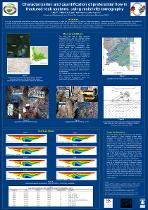 ResearchSpace
ResearchSpace
Characterization and quantification of preferential flow in fractured rock systems, using resistivity tomography
JavaScript is disabled for your browser. Some features of this site may not work without it.
- ResearchSpace
- →
- Research Publications/Outputs
- →
- Conference Publications
- →
- View Item
| dc.contributor.author |
May, F

|
|
| dc.contributor.author |
Mikes, D

|
|
| dc.contributor.author |
Bugan, Richard DH

|
|
| dc.contributor.author |
Jovanovic, Nebojsa

|
|
| dc.contributor.author |
Rozanov, A

|
|
| dc.date.accessioned | 2011-04-11T07:51:51Z | |
| dc.date.available | 2011-04-11T07:51:51Z | |
| dc.date.issued | 2010-11 | |
| dc.identifier.citation | May, F., Mikes, D., Bugan, R. et al. 2010. Characterization and quantification of preferential flow in fractured rock systems, using resistivity tomography. 7th Inkaba Workshop 2010, Potsdam, Germany, 1-5 November 2010, pp 1 | en_US |
| dc.identifier.uri | http://hdl.handle.net/10204/4943 | |
| dc.description | 7th Inkaba Workshop 2010, Potsdam, Germany, 1-5 November 2010 | en_US |
| dc.description.abstract | In the use of unsaturated zone methods to estimate recharge, the basic assumption is made that recharge occurs by means of diffusive processes (i.e. piston flow occurs). In fractured environments the reliability of recharge estimate have been questionable due to preferred pathways influencing the recharge flux. These preferred pathways have been shown to occur throughout sub-Saharan Africa. The focus of this study is to develop improved methodologies to quantify preferential flow in fracture environments. From the quantification of preferential flow pathways it will be possible to differentiate/identify fast flowing (by-pass through fractures) and slow flowing (water in matrix) conduits. This will lead to the estimation of proportions of slow and fast flowing pathways. | en_US |
| dc.language.iso | en | en_US |
| dc.relation.ispartofseries | Workflow;6237 | |
| dc.subject | Preferential flow | en_US |
| dc.subject | Fractured rocks | en_US |
| dc.subject | Resistivity tomography | en_US |
| dc.subject | Rainfall | en_US |
| dc.title | Characterization and quantification of preferential flow in fractured rock systems, using resistivity tomography | en_US |
| dc.type | Conference Presentation | en_US |
| dc.identifier.apacitation | May, F., Mikes, D., Bugan, R. D., Jovanovic, N., & Rozanov, A. (2010). Characterization and quantification of preferential flow in fractured rock systems, using resistivity tomography. http://hdl.handle.net/10204/4943 | en_ZA |
| dc.identifier.chicagocitation | May, F, D Mikes, Richard DH Bugan, Nebojsa Jovanovic, and A Rozanov. "Characterization and quantification of preferential flow in fractured rock systems, using resistivity tomography." (2010): http://hdl.handle.net/10204/4943 | en_ZA |
| dc.identifier.vancouvercitation | May F, Mikes D, Bugan RD, Jovanovic N, Rozanov A, Characterization and quantification of preferential flow in fractured rock systems, using resistivity tomography; 2010. http://hdl.handle.net/10204/4943 . | en_ZA |
| dc.identifier.ris | TY - Conference Presentation AU - May, F AU - Mikes, D AU - Bugan, Richard DH AU - Jovanovic, Nebojsa AU - Rozanov, A AB - In the use of unsaturated zone methods to estimate recharge, the basic assumption is made that recharge occurs by means of diffusive processes (i.e. piston flow occurs). In fractured environments the reliability of recharge estimate have been questionable due to preferred pathways influencing the recharge flux. These preferred pathways have been shown to occur throughout sub-Saharan Africa. The focus of this study is to develop improved methodologies to quantify preferential flow in fracture environments. From the quantification of preferential flow pathways it will be possible to differentiate/identify fast flowing (by-pass through fractures) and slow flowing (water in matrix) conduits. This will lead to the estimation of proportions of slow and fast flowing pathways. DA - 2010-11 DB - ResearchSpace DP - CSIR KW - Preferential flow KW - Fractured rocks KW - Resistivity tomography KW - Rainfall LK - https://researchspace.csir.co.za PY - 2010 T1 - Characterization and quantification of preferential flow in fractured rock systems, using resistivity tomography TI - Characterization and quantification of preferential flow in fractured rock systems, using resistivity tomography UR - http://hdl.handle.net/10204/4943 ER - | en_ZA |





